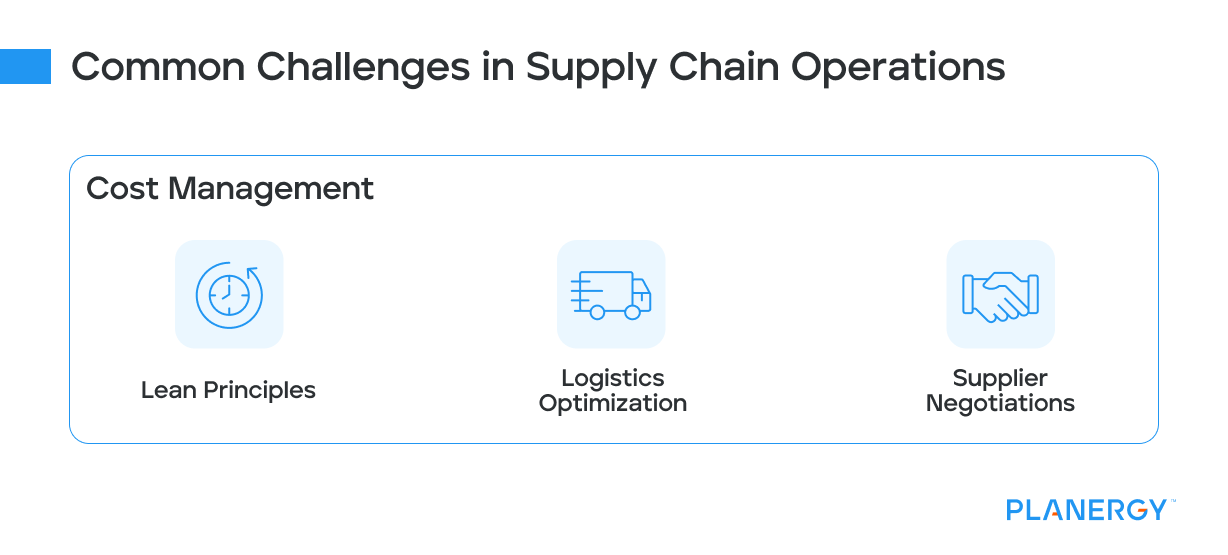In a world where market dynamics shift at lightning speed and consumer demands evolve daily, the resilience of your supply chain is no longer just an operational concern—it’s a necessity.
Imagine navigating a landscape where disruptions are the norm rather than the exception; from global pandemics to geopolitical tensions, businesses must be equipped to pivot swiftly or risk being left behind.
As we stand on the brink of unprecedented technological advancements and environmental challenges, future-proofing your supply chain is not simply a competitive advantage; it’s essential for survival.
We will explore the five most effective strategies for fortifying your supply chain against potential pitfalls while positioning it for sustainable growth.
Whether you’re a seasoned industry leader or a budding entrepreneur, understanding how to adapt and innovate in this critical area can set you apart in an increasingly crowded marketplace.
The New Era of Supply Chains
The new era of supply chains is characterized by extraordinary transparency and agility from end-to-end.
With advanced technologies such as blockchain and AI-driven analytics, companies can monitor every facet of procurement in real time, fostering trust among stakeholders and allowing for hyper-responsive adjustments to market demands.
Digital Transformation
Digitization is revolutionizing supply chains by integrating advanced technologies:

IoT (Internet of Things): IoT devices collect real-time data from every point in the supply chain, from manufacturing to delivery.
For example, smart sensors in trucks monitor location, temperature, and humidity, ensuring optimal conditions for perishable goods.
AI (Artificial Intelligence): AI analyzes vast amounts of big data to predict demand fluctuations and optimize inventory levels.
Retail giants like Amazon use AI to manage inventory, anticipate consumer needs, and minimize shortages.
Blockchain: This technology secures transactions and ensures transparency.
For instance, Walmart uses blockchain to trace the origin of food products, enhancing safety and trust in their supply chain.
Automation
Automation reduces manual intervention, increasing efficiency:

Robotics: Automated guided vehicles (AGVs) and drones streamline warehouse operations, reducing labor costs and improving accuracy.
Companies like Ocado use robots for picking and packing, achieving near-perfect accuracy rates.
RPA (Robotic Process Automation): RPA automates repetitive tasks such as order processing and invoice generation, freeing up human workers for more complex tasks.
This automation is particularly beneficial in industries like manufacturing and logistics.
Resilience and Flexibility
Supply chain resilience and flexibility are critical for adapting to disruptions:

Diversified Supplier Base: By sourcing from multiple suppliers across different regions, companies can mitigate the risk of disruptions.
For example, Toyota’s network of suppliers allows it to maintain production even during regional crises.
Just-in-Case Inventory Models: Unlike just-in-time, this approach maintains higher inventory levels to cushion against unforeseen supply shocks, ensuring continuity.
Local and Regional Networks: Leveraging local suppliers and consolidating suppliers where appropriate reduces dependency on international shipping and minimizes lead times, enhancing agility.
Sustainability
Sustainability is becoming a core strategy in supply chains as companies focus more on environmental, social, and governance (ESG).
To support it in your organization, invest in:
Eco-Friendly Practices: Implementing practices such as reducing packaging waste, using electric delivery vehicles, and optimizing routes to cut emissions.
Renewable Energy: Companies like IKEA invest in renewable energy for their operations, significantly reducing their carbon footprint to help fight climate change.
Circular Economy: Companies can reduce waste and create value by emphasizing product lifecycle management and recycling.
For example, Patagonia repairs and resells used apparel, promoting sustainability.
Practical Steps to Future-Proof Supply Chains
Supply chain leaders must embrace data-driven decision-making to future-proof their operations.
Embrace Technology
Leveraging cutting-edge technology enhances data accuracy, decision-making, and operational efficiency. Strategies include:
Advanced Supply Chain Management Software: Invest in platforms that integrate IoT and AI. These tools provide real-time tracking, predictive analytics, and enhanced visibility across the supply chain.
For example, logistics firms use AI to optimize delivery routes, reducing costs and improving service levels.
Blockchain Implementation: Use blockchain to secure transactions and ensure transparency.
It creates an immutable record of transactions, which is crucial for maintaining trust in pharmaceuticals and food safety industries.
Digital Twins: Create virtual models of supply chain operations to simulate and optimize processes before implementing changes.
Diversity Supply Sources
Relying on a single supplier or region can expose businesses to significant risks.
To address this, focus on:
Supplier Network Expansion: Develop relationships with multiple suppliers across different geographical regions to ensure a steady supply of materials.
This diversification helps mitigate risks associated with geopolitical tensions or natural disasters.
Local Sourcing: Whenever possible, source materials locally to reduce dependency on global supply chains and decrease transportation costs.
Enhance Collaboration
Effective collaboration with partners and stakeholders leads to more synchronized and efficient operations. Make this easy by investing in:
Real-Time Data Sharing Platforms: Utilize collaborative tools like cloud-based systems for seamless communication and data exchange between suppliers, manufacturers, and distributors.
Tools like Microsoft Teams and Slack facilitate real-time data sharing, improving decision-making.
Integrated Planning Systems: Implement systems that allow all stakeholders to participate in forecasting, demand planning, and inventory management, ensuring alignment and reducing inefficiencies.
Invest in Workforce Development
A technologically adept workforce is fundamental for leveraging digital advancements. To make sure you have a staff up to the task, invest in:
Comprehensive Training Programs: Develop continuous learning programs to update employees on the latest technologies and methodologies.
This includes training on data analytics, automation tools, and emerging supply chain trends.
Skill Development Initiatives: Encourage skill diversification, enabling employees to adapt to various roles and responsibilities within the supply chain.
Adopt Sustainable Practices
Sustainability is integral not only for compliance but also for meeting consumer expectations and reducing costs.
To build it into your business consider:
Green Logistics: Optimize transportation routes to reduce fuel consumption and emissions. Implement eco-friendly packaging materials to minimize waste.
Carbon Offset Programs: Engage in initiatives that offset carbon emissions, such as investing in renewable energy projects or reforestation efforts.
Sustainable Sourcing: Partner with suppliers prioritizing sustainability, ensuring your supply chain meets environmental standards.
Common Challenges in Supply Chain Operations
Supply chain operations are fraught with complexities that can quickly escalate into significant challenges.
Supply Chain Disruptions
Natural disasters, geopolitical tensions, and pandemics can severely disrupt supply chain operations, leading to delays and financial losses.
You won’t be able to stop all potential disruptions completely, but you can prepare yourself and protect against more damaging effects with these strategies:

Diversified Sourcing: Establish a network of suppliers across different regions to ensure a steady flow of materials even if one source is compromised.
For example, companies like Apple have diversified their supply chain to reduce reliance on single suppliers or regions.
Flexible Contracts: Negotiate contracts that allow for flexibility in delivery schedules and quantities, enabling quick adjustments in response to disruptions.
Risk Assessment and Contingency Planning: Regularly assess risks and develop comprehensive contingency plans to address potential disruptions.
This includes maintaining safety stock and alternate transportation routes.
Demand Volatility
Rapid changes in consumer demand can lead to overstocking or stockouts, affecting the balance between supply and demand.
Safeguard against this with:

Predictive Analytics: Leverage AI and machine learning tools to analyze market trends and consumer behavior, providing accurate demand forecasts.
Retailers like Zara have effectively used these tools to align inventory with customer demand for predictive procurement.
Agile Supply Chain: Implement an agile supply chain model that allows for rapid production scaling up or down based on real-time demand data.
Collaborative Planning: Work collaboratively with retailers and distributors to gain insights into demand patterns and adjust production schedules accordingly.
Regulatory Compliance
Adhering to varying regulations across different regions can be complex and resource-intensive. Make sure you maintain compliance with:

Compliance Management Software: Use specialized software to monitor regulatory changes and ensure compliance.
These tools can automatically update processes and documentation to meet new standards.
Dedicated Compliance Teams: Establish dedicated teams to oversee compliance efforts, ensuring that the company stays ahead of regulatory changes and minimizes risks.
Training and Education: Regularly train employees on regulatory requirements and best practices to maintain compliance and avoid penalties.
Cost Management
Rising operational costs, including labor, materials, and transportation, can erode profit margins. Get a handle on costs by focusing on:

Lean Principles: Implement lean manufacturing principles to streamline operations, eliminate waste, and optimize resource use.
Companies like Toyota have successfully used lean methods to enhance efficiency and reduce costs.
Logistics Optimization: Use advanced logistics management systems to plan routes, consolidate shipments, and reduce transportation costs.
Supplier Negotiations: Build strong relationships with suppliers to negotiate better terms and pricing, leveraging volume discounts and long-term contracts.
Technology Integration
Adopting new technologies can be disruptive and costly, requiring significant process changes and workforce skills.
But failing to keep up with technology can have grave consequences, so handle it with:

Phased Implementation: Introduce new technologies in phases, allowing time for adjustments and minimizing the risk of disruptions.
This approach ensures a smooth transition and adaptation by the workforce.
Comprehensive Training Programs: Develop training programs to equip employees with the necessary skills to use new technologies effectively, enhancing productivity and minimizing resistance.
Change Management: Implement change management strategies to address cultural and operational shifts, ensuring alignment across the organization and successful technology adoption.
Effective Strategies to Overcome Challenges
Navigating challenges often requires a strategic mindset that embraces adaptability and resilience.
One powerful approach is the practice of reframing problems, which allows individuals to view obstacles from different angles.
Shifting the narrative surrounding a challenge creates opportunities for innovative solutions and reduces feeling overwhelmed.
Implement Supply Chain Risk Management Frameworks
Anticipating and preparing for potential disruptions can significantly reduce their impact on operations.
Conduct routine evaluations to identify vulnerabilities within the supply chain.
This proactive approach allows businesses to prioritize areas that need immediate attention.
Develop detailed contingency plans that outline specific actions to respond to various risk scenarios, such as natural disasters or supply chain interruptions.
This includes backup suppliers and alternative logistics options.
Leverage Data Analytics
Data analytics provides actionable insights that can transform supply chain operations.
Use predictive analytics to optimize inventory levels, reducing both overstock and stockouts. This ensures that inventory aligns closely with demand forecasts.
Analyze customer data to identify trends and preferences, enabling personalized service and quicker response times to customer inquiries and issues.
Strengthen Supplier Relationships
Strong supplier partnerships enhance collaboration and ensure reliability.
Develop long-term relationships with key suppliers, focusing on mutual goals and benefits.
This can involve joint ventures or collaborative innovation projects.
Implement systems to track supplier performance on metrics like quality, delivery time, and cost. Share data and feedback regularly to foster continuous improvement.
Adopt Lean Principles
Lean principles help minimize waste and improve efficiency.
Conduct value stream mapping to identify and eliminate non-value-adding activities, thereby reducing waste and improving flow.
Encourage a culture of continuous improvement (Kaizen) where employees at all levels are empowered to suggest and implement efficiency improvements.
Focus on Customer-Centricity
Aligning supply chain strategies with customer needs enhances service levels and satisfaction.
Regularly collect and analyze customer feedback to identify areas for improvement in product delivery and service.
Develop flexible supply chain strategies that allow for customization based on customer preferences and regional demands.
Future-Proof Your Supply Chain Today for a Better Tomorrow
Future-proofing your supply chain is not just a strategy; it is a necessity in today’s rapidly changing market landscape.
By embracing technology, fostering strong supplier relationships, prioritizing sustainability, diversifying sourcing options, and enhancing risk management processes, businesses can build resilience against disruptions.
These five approaches enhance operational efficiency and position companies for long-term success.
As you consider these strategies, evaluate your current supply chain practices and identify areas for improvement.
Take action today to secure a more robust and adaptable supply chain for tomorrow.













